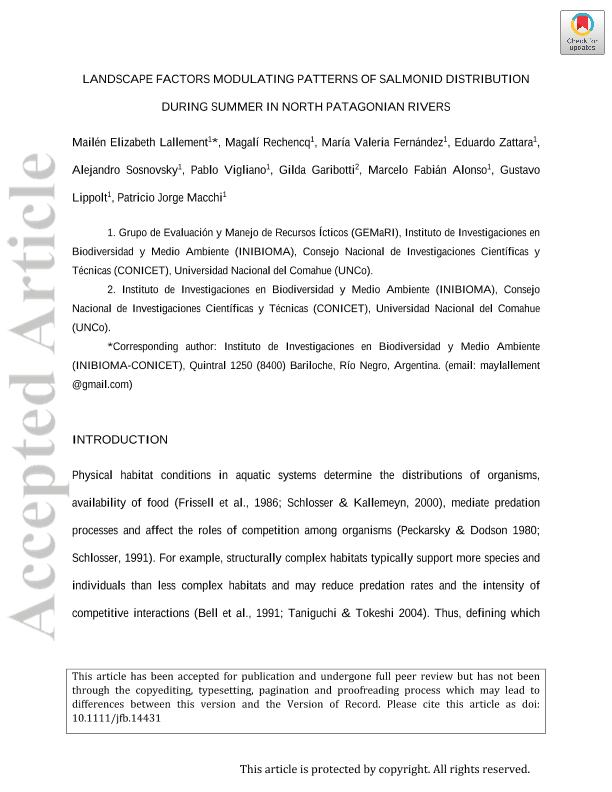Artículo
Landscape factors modulating patterns of salmonid distribution during summer in North Patagonian rivers
Lallement, Mailén Elizabeth ; Rechencq, Magali
; Rechencq, Magali ; Fernández, María Valeria
; Fernández, María Valeria ; Zattara, Eduardo Enrique
; Zattara, Eduardo Enrique ; Sosnovsky, Alejandro
; Sosnovsky, Alejandro ; Vigliano, Pablo Horacio; Garibotti, Gilda Malena; Alonso, Marcelo Fabián; Lippolt, Gustavo Enrique; Macchi, Patricio Jorge
; Vigliano, Pablo Horacio; Garibotti, Gilda Malena; Alonso, Marcelo Fabián; Lippolt, Gustavo Enrique; Macchi, Patricio Jorge
 ; Rechencq, Magali
; Rechencq, Magali ; Fernández, María Valeria
; Fernández, María Valeria ; Zattara, Eduardo Enrique
; Zattara, Eduardo Enrique ; Sosnovsky, Alejandro
; Sosnovsky, Alejandro ; Vigliano, Pablo Horacio; Garibotti, Gilda Malena; Alonso, Marcelo Fabián; Lippolt, Gustavo Enrique; Macchi, Patricio Jorge
; Vigliano, Pablo Horacio; Garibotti, Gilda Malena; Alonso, Marcelo Fabián; Lippolt, Gustavo Enrique; Macchi, Patricio Jorge
Fecha de publicación:
07/2020
Editorial:
Wiley Blackwell Publishing, Inc
Revista:
Journal of Fish Biology
ISSN:
0022-1112
Idioma:
Inglés
Tipo de recurso:
Artículo publicado
Clasificación temática:
Resumen
Understanding how ecosystem processes influencing fish distribution operate across spatial scales is important to understand biological invasions. Salmonids, originally from the Northern Hemisphere, have been repeatedly introduced throughout the world, making them an ideal group to test hypotheses about factors driving invasions. We assessed the influence of environmental variables at the watershed scale on the abundance and structure of salmonid assemblages in the breeding streams of the Upper Limay river basin, Rio Negro, Argentina. We combined field captures with digital map data and geographic information systems to examine landscape-level patterns of salmonid abundance in 35 representative sub-basins of the environmental gradient. We employed a hierarchical cluster analysis and classification and regression tree models to relate the abundance of salmonids and types of species assemblages with environmental characteristics at watershed level. We found stream localization, precipitation regime, altitude and air temperature to be important predictors of the abundance and assemblage structure of salmonids. Total catches showed an increasing gradient of catch-per-unit-effort from west to east and from north to south, with Oncorhynchus mykiss being the most abundant species. O. mykiss relative abundance was westward skewed, where smaller catchments with steeper and shaded valleys are drained by less productive streams with more irregular hydrological regimes, like those found in this species' North American native range. In contrast, the abundance of Salmo trutta abundance was eastward skewed, where larger, sunnier and more gently sloped catchments result in more productive streams with stable hydrological regimes, like those found in that species' European native range. Thus, differential salmonid abundance could result from the interplay between the evolutionary fingerprint left by each species' native environment (especially flow and temperature regimes) and the availability of those conditions in new environments to which they have been translocated. By furthering our understanding of how landscape conditioned invasion success, these findings can help guide the management of economically important introduced fish.
Palabras clave:
ENVIRONMENTAL FILTER
,
FISH ASSEMBLAGES
,
FISH INVASION
,
LIFE HISTORY
,
WATERSHED
Archivos asociados
Licencia
Identificadores
Colecciones
Articulos(INIBIOMA)
Articulos de INST. DE INVEST.EN BIODIVERSIDAD Y MEDIOAMBIENTE
Articulos de INST. DE INVEST.EN BIODIVERSIDAD Y MEDIOAMBIENTE
Citación
Lallement, Mailén Elizabeth; Rechencq, Magali; Fernández, María Valeria; Zattara, Eduardo Enrique; Sosnovsky, Alejandro; et al.; Landscape factors modulating patterns of salmonid distribution during summer in North Patagonian rivers; Wiley Blackwell Publishing, Inc; Journal of Fish Biology; 97; 3; 7-2020; 753-762
Compartir
Altmétricas



